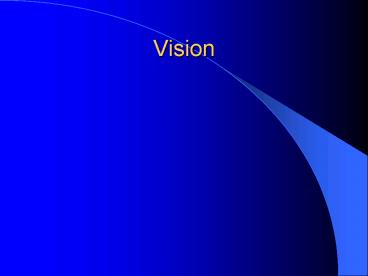Vision - PowerPoint PPT Presentation
1 / 52
Title:
Vision
Description:
Emmetropia = Normal vision, light rays focus on a single point called ... Good for night vision, but poor detail. Convergence. Photoreceptors of Vision. Cones ... – PowerPoint PPT presentation
Number of Views:170
Avg rating:3.0/5.0
Title: Vision
1
Vision
2
Anatomy of the Eye
- Fibrous tunic
- Sclera
- Cornea
3
(No Transcript)
4
Anatomy of the Eye
- Vascular tunic Uvea
- Choroid
- Ciliary body
- Iris
- Pupil
5
(No Transcript)
6
Anatomy of the Eye
- Nervous tunic Retina optic nerve
- Outer pigmented layer
- Nervous layer
7
(No Transcript)
8
(No Transcript)
9
(No Transcript)
10
Photoreceptors
- Rods
- Cones
- Macula
- Fovea centralis
11
(No Transcript)
12
(No Transcript)
13
(No Transcript)
14
(No Transcript)
15
- Optic Nerve
- Optic disc
- Blind Spot
16
Anatomy of the Eye Miscellaneous structures
- Lens
- Anterior cavity
- Aqueous humor
- Posterior cavity
- Vitreous humor
17
(No Transcript)
18
Anatomy Accessory structures
- Eyelids Palpebrae
- Tarsal plate
- Meibomian glands
- Palpebral fissure
- Lateral commissure
- Medial commissure
- Caruncle
- Sebaceous ciliary glands
19
(No Transcript)
20
(No Transcript)
21
(No Transcript)
22
(No Transcript)
23
Anatomy Accessory structures
- Conjunctiva
- Palpebral
- Bulbar
24
(No Transcript)
25
Anatomy Accessory structures
- Lacrimal apparatus
- Function
- Lacrimal gland
- Lacrimal puncta
- Lacrimal canal
- Nasolacrimal duct
26
(No Transcript)
27
Vision
- Light
- Refraction
- Emmetropia Normal vision, light rays focus on a
single point called the Focal Point
28
(No Transcript)
29
(No Transcript)
30
Focal Point
31
Retina
32
(No Transcript)
33
(No Transcript)
34
(No Transcript)
35
Vision
- Accommodation
- For close vision
- Pupils constrict
- Eyeballs converge
- Near point of vision
36
Vision
- Eye movement controls
- Voluntary fixation (premotor area)
- Involuntary fixation (visual area)
37
Vision
- Binocular vision
- Diplopia
- Strabismus
38
(No Transcript)
39
Photoreceptors of Vision
- Rods
- Rhodopsin is photopigment
- Numerous about 120 million
- Sensitive to light
- Relative lack of color discrimination
- Peripheral retina in location
- Good for night vision, but poor detail
- Convergence
40
(No Transcript)
41
(No Transcript)
42
(No Transcript)
43
Photoreceptors of Vision
- Cones
- Few about 6 million
- Photopigments sensitive to differing wavelengths
of light - 400 nm blue
- 500 nm green
- 600 nm red
44
(No Transcript)
45
Photoreceptors of Vision
- Cones
- High level of illumination
- Not very sensitive to light
- See in color
- Precise detail
- Little convergence
- Mostly in center of retina, esp. fovea
46
Neural Components of Vision
- Bipolar neurons
- Ganglion neurons
- Lateral inhibition
- Horizontal cells
- Amacrine cells
47
(No Transcript)
48
(No Transcript)
49
Visual Acuity
- Snellen Eye Chart
- 20/20
50
Light/Dark Adaptation
- Photopigment concentration
- Pupillary light reflex
- PNS constricts pupil
- Direct ipsilateral
- Indirect Consensual - contralateral
- Cones inhibit rods in bright light
51
Visual Pathway
- Optic Nerve
- Optic Chiasma
- Optic tracts
- Thalamus lateral geniculate body
- Occipital lobe of cerebral cortex
52
(No Transcript)































